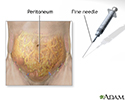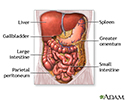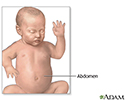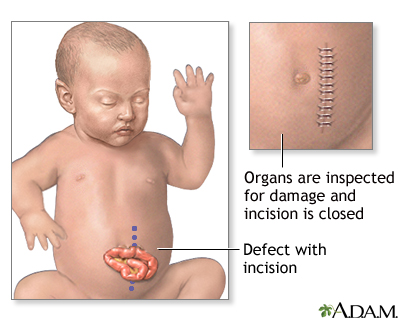Peritonitis
Acute abdomen; Spontaneous bacterial peritonitis; SBP; Cirrhosis - spontaneous peritonitis
Peritonitis is an inflammation (irritation) of the peritoneum. This is the thin tissue that lines the inner wall of the abdomen and covers most of the abdominal organs.
Causes
Peritonitis is caused by a collection of blood, body fluids, or pus in the belly ( abdomen ).
Abdomen
An abdominal abscess is a pocket of infected fluid and pus located inside the belly (abdominal cavity). This type of abscess can be located near or ...

One type is called spontaneous bacterial peritonitis (SPP). It occurs in people with ascites. Ascites is the buildup of fluid in the space between the lining of the abdomen and the organs. This problem is found in people with long-term liver damage, certain cancers, and heart failure.
Peritonitis may be a result of other problems. These include:
- Trauma or wounds to the belly
- Ruptured appendix
-
Ruptured diverticula
Ruptured diverticula
Diverticula are small, bulging sacs or pouches that form on the inner wall of the intestine. Diverticulitis occurs when these pouches become inflame...
 ImageRead Article Now Book Mark Article
ImageRead Article Now Book Mark Article - Infection after any surgery in the belly
Symptoms
The belly is very painful or tender. The pain may become worse when the belly is touched or when you move.
Your belly may look or feel bloated. This is called abdominal distention .
Abdominal distention
Abdominal bloating is a condition in which the belly (abdomen) feels full and tight. Your belly may look swollen (distended).

Other symptoms may include:
-
Fever
and chills
Fever
Fever is the temporary increase in the body's temperature in response to a disease or illness. A child has a fever when the temperature is at or abov...
 ImageRead Article Now Book Mark Article
ImageRead Article Now Book Mark Article - Passing little or no stools or gas
- Excessive fatigue
-
Passing less urine
Passing less urine
Decreased urine output means that you produce less urine than normal. Most adults make at least 500 ml of urine in 24 hours (a little over 2 cups)....
 ImageRead Article Now Book Mark Article
ImageRead Article Now Book Mark Article -
Nausea and vomiting
Nausea and vomiting
Nausea is feeling an urge to vomit. It is often called "being sick to your stomach. "Vomiting or throwing-up is forcing the contents of the stomach ...
 ImageRead Article Now Book Mark Article
ImageRead Article Now Book Mark Article - Racing heartbeat
- Shortness of breath
Exams and Tests
The health care provider will perform a physical exam. The abdomen is usually tender. It may feel firm or "board-like." People with peritonitis usually curl up or refuse to let anyone touch the area.
Blood tests, x-rays, and CT scans may be done. If there is a lot of fluid in the belly area, the provider may use a needle to remove some and send it for testing.
Treatment
The cause must be identified and treated right away. Treatment typically involves surgery and antibiotics.
Possible Complications
Peritonitis can be life threatening and may cause complications. These depend on the type of peritonitis.
When to Contact a Medical Professional
Go to the emergency room or call the local emergency number (such as 911) if you have symptoms of peritonitis.
References
Kuemmerle JF. Inflammatory and anatomic diseases of the intestine, peritoneum, mesentery, and omentum. In: Goldman L, Schafer AI, eds. Goldman's Cecil Medicine . 25th ed. Philadelphia, PA: Elsevier Saunders; 2016:chap 142.
Levinson ME, Bush LM. Peritonitis and intraperitoneal abscesses. In: Bennett JE, Dolin R, Blaser MJ, eds. Mandell, Douglas, and Bennett's Principles and Practice of Infectious Diseases . 8th ed. Philadelphia, PA: Elsevier Saunders; 2015:chap 76.
Runyon BA; AASLD. Introduction to the revised American Association for the Study of Liver Diseases Practice Guideline: management of adult patients with ascites due to cirrhosis 2012. Hepatology . 2013;57(4):1651-1653. PMID: 23463403 www.ncbi.nlm.nih.gov/pubmed/23463403 .
-
Peritoneal sample - illustration
The peritoneum is the membrane lining the abdominal cavity.
Peritoneal sample
illustration
-
Abdominal organs - illustration
The stomach and intestines are the main organs of digestion, coverting and breaking down food into substances which are either absorbed by or excreted from the body.
Abdominal organs
illustration
-
Gastroschisis repair - series
Presentation
-
Peritoneal sample - illustration
The peritoneum is the membrane lining the abdominal cavity.
Peritoneal sample
illustration
-
Abdominal organs - illustration
The stomach and intestines are the main organs of digestion, coverting and breaking down food into substances which are either absorbed by or excreted from the body.
Abdominal organs
illustration
-
Gastroschisis repair - series
Presentation
Review Date: 2/27/2016
Reviewed By: Debra G. Wechter, MD, FACS, general surgery practice specializing in breast cancer, Virginia Mason Medical Center, Seattle, WA. Also reviewed by David Zieve, MD, MHA, Isla Ogilvie, PhD, and the A.D.A.M. Editorial team.







